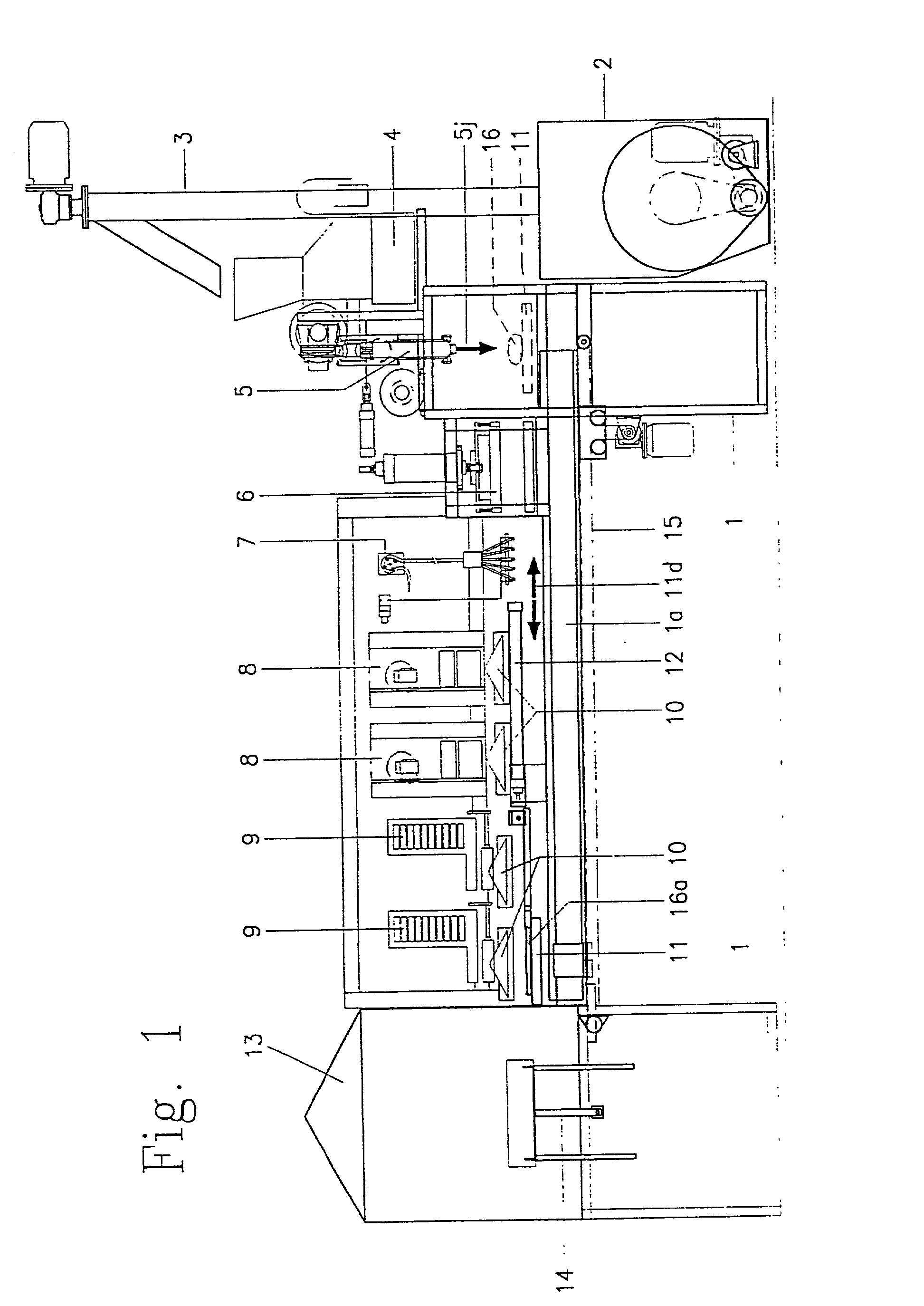[0025] The invention does not exclude that one or several of the above-recited novel devices are replaced by one or several corresponding conventional devices. The kneading and
extrusion device is an essential component of the method. Two transport and kneading worms, operating perpendicular to each other, allow the kneading and
extrusion device to realize an effective mixing of the dough components (flour, salt,
sugar,
yeast, water, etc.), a homogenization, an interspersing, a densification, and finally the extrusion with the
discharge of the portion amount based on an independently controllable rotational speed of the two worms relative to each other. The core piece of this kneading and extrusion device is the transition region from the first worm to the second worm, wherein the second worm disposed perpendicular to the first worm. The dough
mass is subjected in this region to a torsion motion with repeated shearing by the worm wall, which effects an intensive interspersing under formation of air bubbles and homogenization, which equals an intensive and continuous kneading through of the
mass and is decisive for a uniform shaping and baking through of the flat cake or pizza. The arrangement according to the present invention of the worms, their construction form and the tuning of the worm casing allow in a short time to extrude a professionally prepared portion of dough. The apparatus is cleanly flushed and sterilized with hot air according to a pre-programmed washing and sterilization cycle through an increase of the rotation speed and change of the rotation direction of the worms. A compact dough portion is extruded in case of a proper metering of the ingredients of the dough mixture and upon an exact tuning of the rotation speeds of the two worms. The dough portion is separated at the
discharge of the casing, possibly by way of a
cutting device, and falls onto the transport plate readied under the casing
discharge. A closure plate at the input of the casing and the possible
cutting device at the discharge of the casing or at the extrusion
nozzle close the kneading device during the standstill of the worms. The transport plate according to the present invention can be produced of different materials and is preferably heated or preheated by electrical thermal resistors so that the dough, or, respectively, the flat cake does not stick to the transport plate and becomes pre-heated during the following work phases in order to obtain thereby the required rigidity in order to not to deform during placement into the baking oven and in order to shorten the baking time.
[0027] The shaping of the flat cake according to the present invention is performed under a press which flattens the dough portion to a predetermined thickness by lowering a horizontal disk against the transport plate disposed below the horizontal disk. The lowerable heated disk is furnished with a ring which is supported horizontally shiftable at a distance to the circular disk's outer edge when subjected to a spring interaction. This ring furnishes a circular form to the outer edge of the flat cake by forming a bead in the
intermediate space between the extruder's outer edge and the inner side of the ring during the
stamping procedure from the dough squeezed out laterally from between the transport plate and the extruder plate. Initially, the ring rests at the surface of the transport plate during the
stamping procedure. Then, based on a further lowering of the press plate, the dough portion is flattened to a flat cake or flat dough base. The springs between the support of the ring and the ring are compressed during this phase. Then the press plate is lifted up again, the springs can thereby be relaxed again. This bead forms at the same time a barrier in order to prevent during the following a distribution of tomato pulp, sauces or purees. The formation of the flat cake with the described apparatus is time-saving and allows always to form a uniform round flat cake with a thicker upwardly projecting
edge region even in case of a somewhat different dough portion; simultaneously, it is prevented with the heated transport plate and press plate that the dough sticks to the plate surfaces and achieves a pre-heating of the flat cake.
[0029] The metering device according to the invention for garnishing ingredients in bubble bands includes a mechanical roller device, wherein the mechanical roller device pulls the bubble band with the welded-in portions from the cooled storage box, and wherein the mechanical roller device pulls apart the two welded foils of the bubble band above the dispersing mechanism, whereby the ingredient portions (finely
cut soft cheese, ham pieces, vegetable pieces, etc.) fall onto the dispersing device and are dispersed by vibration by the dispersing device by falling through a
sieve and / or through a grate onto the flat cake disposed below the dispersing device. The sieves and / or grates can be easily exchanged and are made out of a dish-washing-
machine-proof material or out of materials which provide for a
single use; this invention feature allows to maintain hygienic conditions in a simple way by changing the
sieve. The rolled-off foil bands in contrast can run into their own container or can also run back into the cooled container of the bubble band.
 Login to View More
Login to View More  Login to View More
Login to View More 


